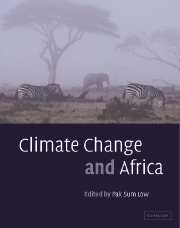Book contents
- Frontmatter
- Contents
- Notes on contributors
- Peer reviewers
- Editor's note
- Foreword
- Foreword
- Foreword
- Foreword
- Preface
- Preface
- Preface
- Preface
- List of abbreviations
- List of SI prefixes
- List of unit abbreviations
- List of chemical formulae
- Part I Science
- 1 Holocene climatic, hydrological and environmental oscillations in the tropics with special reference to Africa
- 2 The relative importance of the different forcings on the environment in Ethiopia during the Holocene
- 3 Global warming and African climate change: a reassessment
- 4 Interactions of desertification and climate in Africa
- 5 Africa's climate observed: perspectives on monitoring and management of floods, drought and desertification
- 6 Atmospheric chemistry in the tropics
- 7 Natural and human-induced biomass burning in Africa: an important source for volatile organic compounds in the troposphere
- 8 Biomass burning in Africa: role in atmospheric change and opportunities for emission mitigation
- 9 Soil micro-organisms as controllers of trace gas emissions over southern Africa
- Part II Sustainable energy development, mitigation and policy
- Part III Vulnerability and adaptation
- Part IV Capacity-building
- Part V Lessons from the Montreal Protocol
- Index
5 - Africa's climate observed: perspectives on monitoring and management of floods, drought and desertification
Published online by Cambridge University Press: 10 December 2009
- Frontmatter
- Contents
- Notes on contributors
- Peer reviewers
- Editor's note
- Foreword
- Foreword
- Foreword
- Foreword
- Preface
- Preface
- Preface
- Preface
- List of abbreviations
- List of SI prefixes
- List of unit abbreviations
- List of chemical formulae
- Part I Science
- 1 Holocene climatic, hydrological and environmental oscillations in the tropics with special reference to Africa
- 2 The relative importance of the different forcings on the environment in Ethiopia during the Holocene
- 3 Global warming and African climate change: a reassessment
- 4 Interactions of desertification and climate in Africa
- 5 Africa's climate observed: perspectives on monitoring and management of floods, drought and desertification
- 6 Atmospheric chemistry in the tropics
- 7 Natural and human-induced biomass burning in Africa: an important source for volatile organic compounds in the troposphere
- 8 Biomass burning in Africa: role in atmospheric change and opportunities for emission mitigation
- 9 Soil micro-organisms as controllers of trace gas emissions over southern Africa
- Part II Sustainable energy development, mitigation and policy
- Part III Vulnerability and adaptation
- Part IV Capacity-building
- Part V Lessons from the Montreal Protocol
- Index
Summary
Keywords
Drought; desertification; floods; climate; ENSO; satellite observations; GIS; disaster management; weather modification; open-source; geomatics
Abstarct
Satellite imagery and in situ data processed in a geographic information system offer perspectives on Africa's climate. Areas of relatively high precipitable water vapour extend more widely than areas of high precipitation, suggesting that improved weather modification (e. g. stimulating precipitation) might benefit desertification mitigation efforts. Processed Normalized Difference Vegetation Index data offer perspectives on the current state of desertification risk. The Vegetation Condition Index, used with compilations of environmental associations with ENSO, and with ENSO and weather forecasts, offer tools for agricultural, water resources and public health managers to respond to drought. Finally, evolving capabilities in satellite observations of flooding, global and regional digital elevation data, geomatics software, and regional cooperative mechanisms, offer tools for improved flood management.
INTRODUCTION
Africa's climate has been summarized many times in the past; it is not the purpose of this effort to repeat such exercises. Instead, this chapter uses scientific geographic information systems (GIS) to focus on aspects of climate parameters related to drought, desertification risk, and flooding. Such approaches deserve more widespread attention by those attempting to respond to climate change, including decision makers that must set national policy, or to build national or regional capacity responding to these issues. This chapter draws on significant progress over the last decade in compiling spatial environmental data, such as the Global Ecosystems Database (NOAA-EPA Global Ecosystems Database Project (1992)).
- Type
- Chapter
- Information
- Climate Change and Africa , pp. 50 - 59Publisher: Cambridge University PressPrint publication year: 2005
- 2
- Cited by



